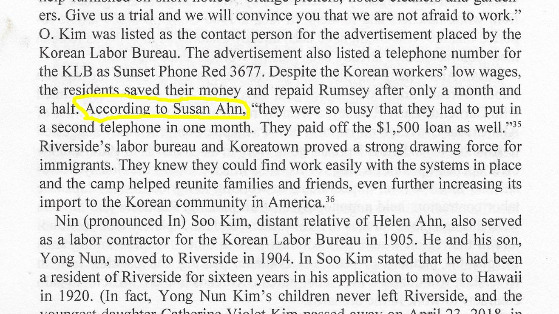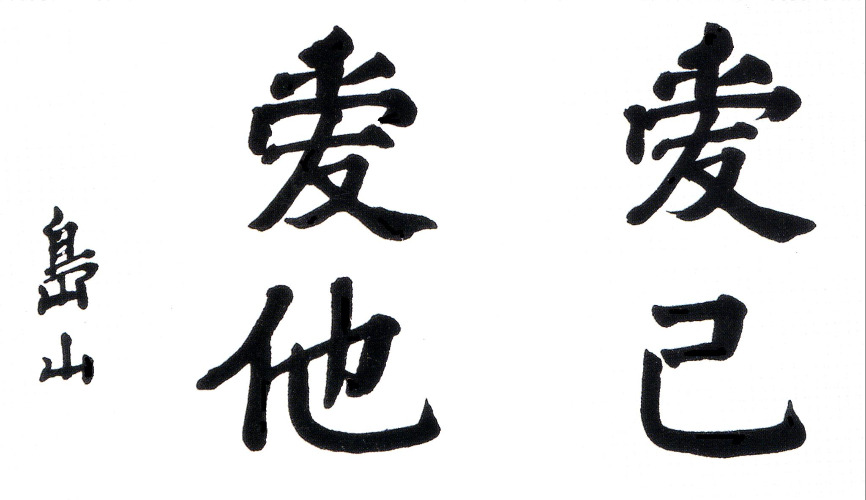Pachappa Camp is based on incorrect and revised history. This book should not be considered a straightforward assessment of the history of Pioneer Koreans in America during the Independence Movement. It clearly misrepresents Dosan Ahn Chang Ho's history. It should have never gone to print.
There are far too many
INCORRECT FACTS
Page 3 "It is important to note that the third Korean National Association of North America convention was held in Riverside right after Dosan returned to America."
The convention was not held right after Dosan returned to America. Dosan traveled for weeks before arriving in Riverside The two previous Korean National Association conventions were held in Redlands in 1909 and Claremont in 1910? If Riverside as claimed in Pachappa Camp was the Mecca why weren't all of the conventions held at Pachappa Camp? The 1912 convention was held in San Francisco. If Riverside was the most important place in the Independence Movement in America why did the 1911 convention make Los Angeles the KNA Headquarters? Many claims about Riverside are made on limited historical information.
Page 3 "Not only did Dosan's family reside in Riverside, but Pachappa Camp was the center of independence activities during the early twentieth century in America."
Where is the proof Pachappa Camp was the center of anything during the early twentieth century. This period is usually between 1900 and 1930. This claim excludes all other areas where Koreans were living and working. Why were the headquarters of the Chinmokhoe,Gongnip Association, Korean National Association, Taedong Pokugkhoe, Hungsadan and Dongjihoe located in Los Angeles and San Francisco not Pachappa? Accodring to Lee Sun Ju the Redlands Gongnip Association was formed in Redlands in 1905 before Riverside was formed in 1906.
Page 4 "Until now, scholars and researchers paid very little attention to how and why Dosan Ahn Chang Ho was deported by the US Immigration Service Office in 1926."
The Dosan deportation information was published and researched in the early 2000's. The file was first publicized by Susan Ahn Cuddy after Elaine May Woo located it in the San Francisco National Archives while researching Anna Me Wong. The file appeared in a search about Philip Ahn and his family. The documents were copied and given to Susan Ahn Cuddy who had the information published in Chosun Weekly through Lia Kim. Pachappa Camp includes the information but did not address the how or why Dosan was deported as claimed. See Colonel Young Oak Kim.
Page 4 "I also intend to pinpoint Riverside, California, as one of the most important historical sites of Dosan Ahn Chang Ho's life in America."
Pachappa Camp does not pinpoint Pachappa as one of the most important historical sites on any level. If it was so important why didn't Dosan remain there or return there after 1913? Again, there were numerous other historical sites in America that were much more important than Riverside or Pachappa.
If Pachappa was important enough to call it the Mecca of Korean Independence why didn't Colonel Young Oak Kim's father come there in 1910 when he arrived from Korea?
Page 15 - "Philip Ahn born in Pachappa"
Incorrect. Philip Ahn was born in Highlnd Park March 29, 1905. Highland Park is near Los Angeles 55 miles West of Riverside. Philip Ahn's birth date and place is easy to find out. There is no question he was born in Los Angeles except for the wrong place of birth given by Edward Chang and UC Riverside. Ed Chang will blame it on Rev. Lee Sun Ju. However, on page 139 of Pachappa Camp Professor Edward Chang brags he is a PROLIFIC RESEARCHER. Chang's work page after page is a clear example of shoddy research and bad editing, also. Chang is prolific as a limited researcher.
Page 15 - "...the camp continued to thrive and functioned as a center for the Korean immigrant community until November 1918."
Pachappa was never the center of the Korean immigrant community from 1905 to 1918. All Korean community organization Headquarters were in San Francisco or Los Angeles. Riverside was a branch location of the bigger organizations like Gongnip Hyophoe and Korean National Association.
Pachappa did not "thrive" as it collapsed after the 1913 citrus freeze. By 1920 there were 20 Koreans in Riverside.
Page 20 - Korean Labor Bureau clarification
The Korean Labor Bureau (KLB) was initiated as part of the Chinmokhoe in San Francisco established in 1903. Dosan was the President. Besides San Francisco and Riverside there was a KLB office in Redlands. Dosan history expert Yun Pyong Sok of Inha University states in Strengthened Abilities on page 50 the Chinmokhoe: "...took the responsibility of finding jobs for Korean laborers and guaranteed them minimum wages." The Chinmokehoe labor agency sent Yi Kang, Im Jung Ki, Chung Jae Kwon and Im Chi Keong as a citrus work test team to Riverside before Dosan went there. Yi Kang and Im Jung Ki found Pachappa Camp not Dosan.
Endorsement by Angie Y. Chung University at Albany on back cover.
It is 100% incorrect to claim "... the camp is significant not only as a symbolic and institutional site for early Korean families and laborers, but also, as the lifeblood for the Korean American independence movement against Japanese colonization."
Pachappa Camp was not the "lifeblood" of the Korean American independence movement. Does Dr. Chung endorse a book she did not read? If Dr. Chung did read Pachappa Camp she misunderstood (it is written so poorly it is difficult to read) the book or is completely ignorant of Korean history, Korean American history, Independence Movement history and Dosan's history. Maybe Dr. Chung doesn't know what a town or settlemnt is. This is a case of blindly following Ed Chang. Dr. Chung conflicts with the 3rd of Dosan's Four Principles by blindly following others. There are far too many other significant episodes in the story of Pioneer Koreans and Dosan proving Pachappa cannot be accurately claimed the "lifeblood". Pachappa was a migrant labor camp not an independence movement center. Pachappa was basically dead after 1913. Koreans in America and overseas were actively fighting the Japanese Occupation until 1945. How could it be claimed the "lifeblood"?
Chang Misrepresents Susan Ahn Cuddy and John Cha
You can't make the same mistake twice. The second time you make it is not a mistake, it is a choice!

Incorrect - "Mistake 1"
Pachappa Camp has far too many mistakes and false claims to be used as a source of history. Look at the incorrect reference to Susan Ahn Cuddy above. Susan Ahn Cuddy did not make these comments. This quotes was taken from John Cha's book Willow Tree Shade. The book clearly stated who the words came from. Not from Susan Ahn Cuddy. Three examples of bad research, careless editing and no fact checking by Joong Hwan Oh the Series Editor or by Rowman and Littlefield the publisher. This is another example of the low-quality and mediocre level of professionalism behind Pachappa Camp.

Incorrect - "Mistake 2" there are more!!!
Same incorrect use of Susan Ahn Cuddy on a quote from Willow Tree Shade Susan Ahn Cuddy did NOT make. This example of shoddy academic writing and irresponsible publishing are reasons why Korean and Korean American history are so poorly taught in America and Korea. Pachappa Camp has a pattern of errors and misrepresentations that suggest history has been harmfully revised. There are so many questionable claims made. Many well known relevant important details are left out making the information incomplete. In my opinion, Pachappa Camp - if you can stomach the horrific writing itself - is the product of a backhanded strategy to selectively put the facts together to control the historical narrative not teach history.
Page 25 - "Riverside proved a popular location for Koreans because of the work available and the Koreatown in place. Families moved to Riverside constantly to earn a steady living, support friends and relatives, and to seek educating there children."
When was "Koreatown in place"? When Dosan arrived in Riverside there were five Koreans there in late 1904. When Dosan left Riverside in March of 1905 there were 18 Korans there. If Koreatown was in place with steady living why did Helen Ahn leave Riverside, go to Highland Park near Los Angeles and give birth to Philip Ahn on March 29, 1905? Where are the statistics proving "Families moved to Riverside constantly?"
Pages 29, 58-59 - Mrs. Mary Stewart overlooked
There is much more to Mary Stewart than provided by Pachappa Camp. Mrs. Mary Stewart of Upland was an employer of Koreans and a protector of Koreans who worked in her family's citrus orchards. Mrs. Stewart supported Koreans in Claremont as well as Riverside. The group photo below is Mrs. Stewart with Koreans in Claremont. Mrs. Stewart has an extensive involvement in early twentieth century history of Koreans in America. The minimal mention of her name as an attendee at church in Riverside excludes valuable details of early Korean immigrant life and history. See Korean American Heritage website for more details about the Stewarts and Koreans.
Korean Communities Across the World
Series Editor Joong-Hwan Oh
What does a Series Editor do? How could Dr. Oh approve Pachappa Camp incorrect historical information? How could Dr. Oh approve such poor writing? What did Dr. Oh do to sell this story to Lexington Books and Rowman and Littlefield? Was there ever a qualified historian who got the job to fact check? Dr. Oh did not pay attention to his responsibilities.
Dosan Memorial Foundation Seoul, Korea
The Dosan Memorial Foundation of Korea is criticized in Pachappa Camp for incorrectly researching and neglecting the significance of Pachappa Camp and Riverside. How does Pachappa Camp justify these accusations?
On December 1, 2016 an email was sent from the Dosan Memorial Foundation office in Seoul to The City of Riverside hired Historian Jennifer Mermalloid requesting a review of the Pachappa Camp documents used in the Hearing. Jennifer Mermalloid and people in Riverside rejected the request from Dosan expert historian Dr. Yoon Kyung Ro and Foundation Manager Ahn Byung So.
How can the Dosan Memorial Foundation of Seoul Korea be criticized by Chang while not being allowed to review City of Riverside Pachappa Camp Application materials?

